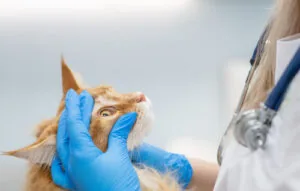Feline Leukemia

What is Feline Leukemia?
Feline Leukemia Virus (FeLV) is one of the most common and destructive of all cat viruses. It is highly contagious and is spread primarily by saliva during cat fights, grooming or mating. The virus is also spread by blood, urine and feces. Kittens may become infected while still in the womb, when the mother bites off the umbilical cord or during nursing.
Cats Infected with Felv May Display the Following Symptoms:
- Yellowish color in the mouth or whites of eyes
- Pale gums
- Enlarged lymph nodes
- Upper respiratory illnesses
- Bladder infections
- Skin rashes
- Weight loss
- Poor coat condition
- Progressive weakness
- Lethargy
- Fever
- Diarrhea
- Breathing issues
- Stomatitis (An oral disease which causes ulcerations)
How Is It Transmitted?
Not all cats exposed to FeLV become infected. About 40% of exposed cats have immune systems that destroy the invading virus. The remainder of exposed cats become persistently infected (30%) or develop a latent infection (30%). The latter group has inactive virus in their bone marrow, and these virus particles may later become active when the cat becomes ill from another disease, stress or certain drugs. Of the cats persistently infected, about 25% will die within 1 year and 75% will die within 3 years. Some may live a normal life but tend to have various chronic illnesses.
Felines can’t transmit FeLV to dogs or people.Cats contract the virus when they come into direct contact with infected bodily fluids; saliva, nasal secretions, blood, urine and feces. Otherwise healthy felines can spread FeLV during high-risk activities. Some cats become infected when grooming. Kittens may contract the illness when they drink milk from nursing mothers. Other transmissions occur when cats receive bites during a fight. Risks of environmental infections are low. The virus only lives a few hours outside after it leaves a cat’s body.
Risk Factors
Sick cats are four times more likely than healthy cats to be infected with FeLV. Researchers estimate that about 50 percent of cats with severe bacterial infections, and 75 percent of cats with toxoplasmosis, a protozoan disease, also have FeLV infections. Males are 1.7 times more likely to be infected than females, and younger cats are more susceptible to infection than older cats. FeLV is found mostly in cats from 1 to 6 years old; the average age is 3 years. Outdoor cats are more likely to be infected with FeLV. Less than 1 percent of healthy indoor cats in the United States are infected with FeLV, compared to 1 to 2 percent of healthy outdoor cats, and more than 13 percent of sick stray cats. FeLV is more common in multicat households than in single-cat households, especially when cats go outdoors. Exposure to infected cats raises the risk of FeLV infection. Young adult cats and kittens have a higher chance of contracting the disease. Felines grow resistance to the virus as they age, so older cats are less likely to contract the virus.
How Veterinarians Diagnose FeLV and Treatments
Owners should test any sick cat they suspect has FeLV. Your veterinarian can diagnose the infection using the ELISA blood test. This highly sensitive test finds the disease in its earliest stages by identifying the proteins in your cat’s bloodstream. Some cats can eliminate the infection from their bodies and will test negative later. Cats should only take the test 30 days after a possible exposure.
It’s an unfortunate fact that 85% of cats with chronic FeLV infections will die within three years of their diagnosis. A veterinarian can provide preventative and supportive care to help infected cats live comfortably and to protect them from secondary infections. Pet owners should keep FeLV-infected cats indoors, so they don’t infect others.
Always keep your cat indoors to stop them from interacting with FeLV-infected felines. Pet owners should have new cats or kittens over eight weeks old tested for the virus before bringing them into a multi-cat household and also bring all cats/kittens to get regular FeLV vaccinations. It’s not safe to introduce a new cat into a FeLV positive households, because the pet may have a high risk of contracting the disease, even with vaccination. Additionally, another pet can add stress and negatively impact the FeLV positive cat. If you suspect your cat has FeLV infection or they are at high risk of contracting the disease, contact your local veterinarian to schedule an appointment today.
Share This Post
Recent Posts
About Shallowford Animal Hospital
Shallowford Animal Hospital and The Pet Spa at Shallowford are dedicated to the exceptional, compassionate care your pet deserves. Pets hold a very special place in our families, and we treat yours like our own.



